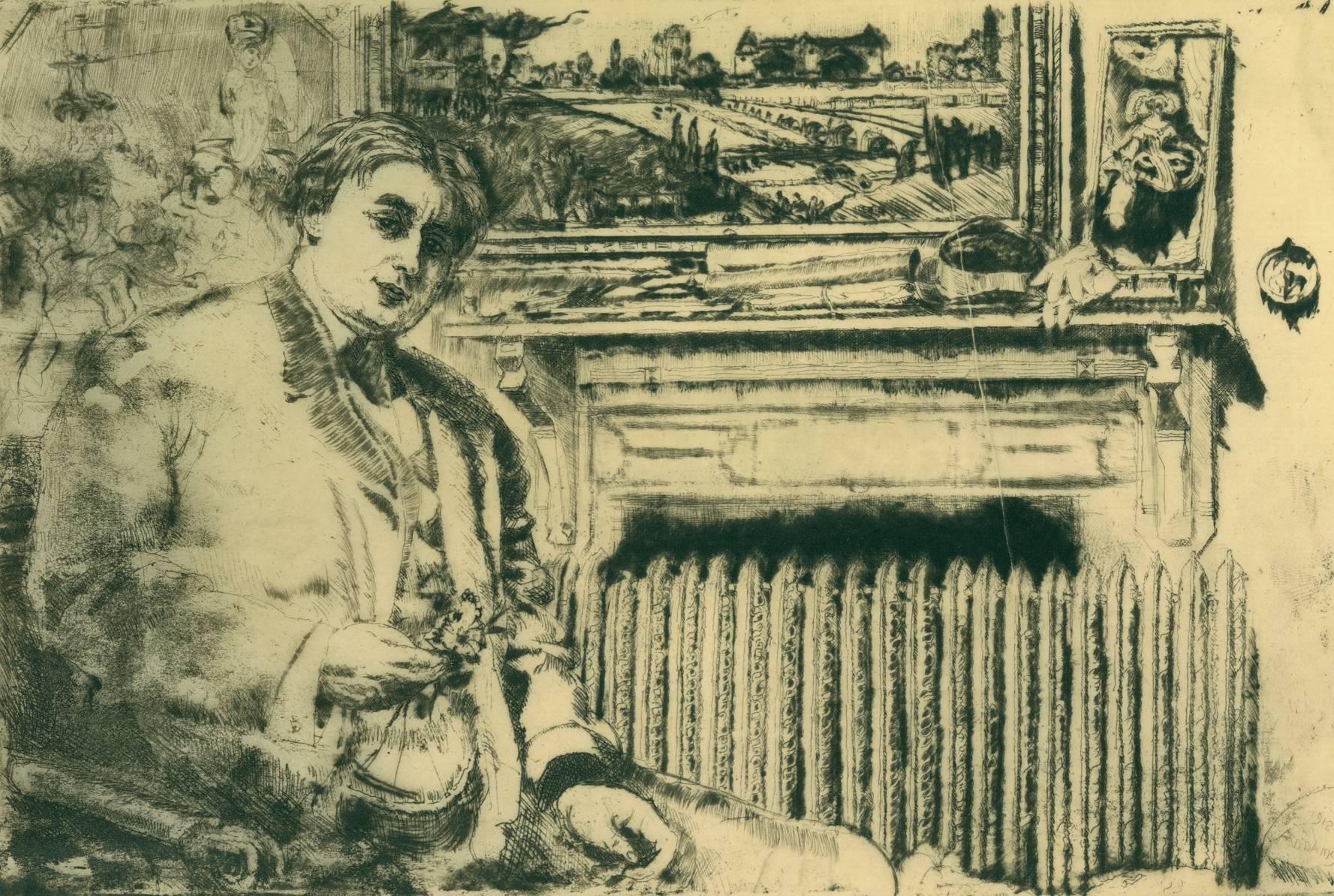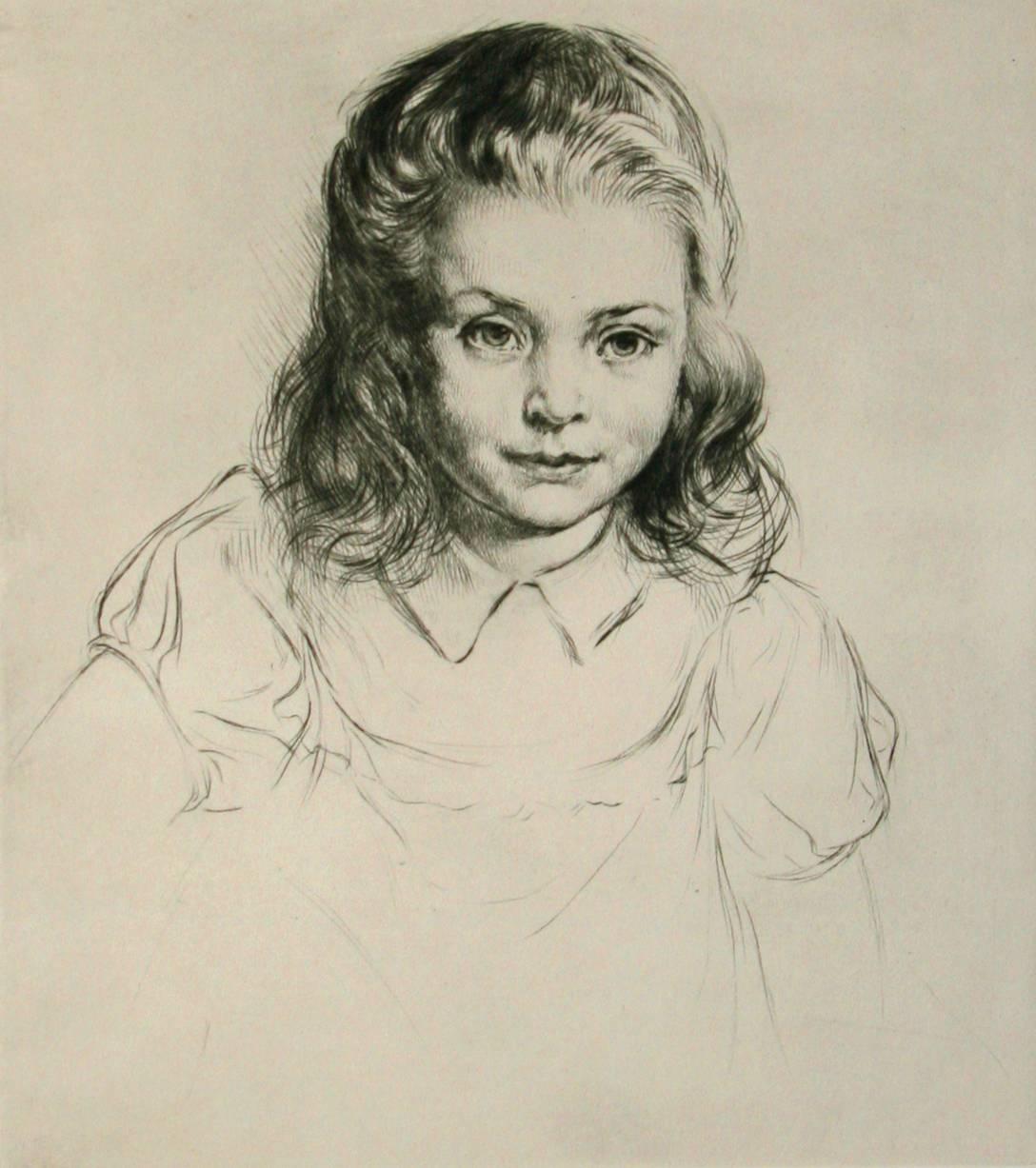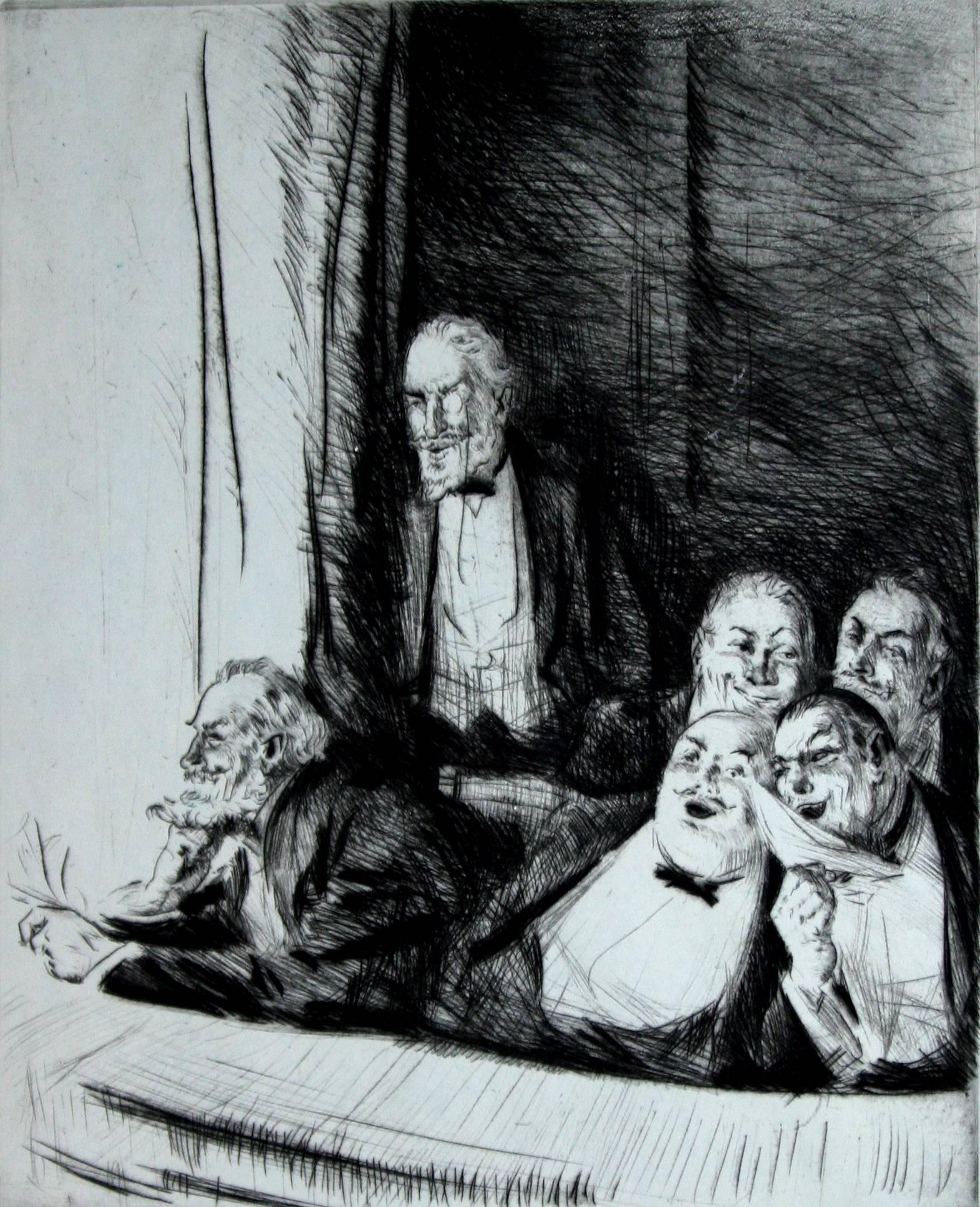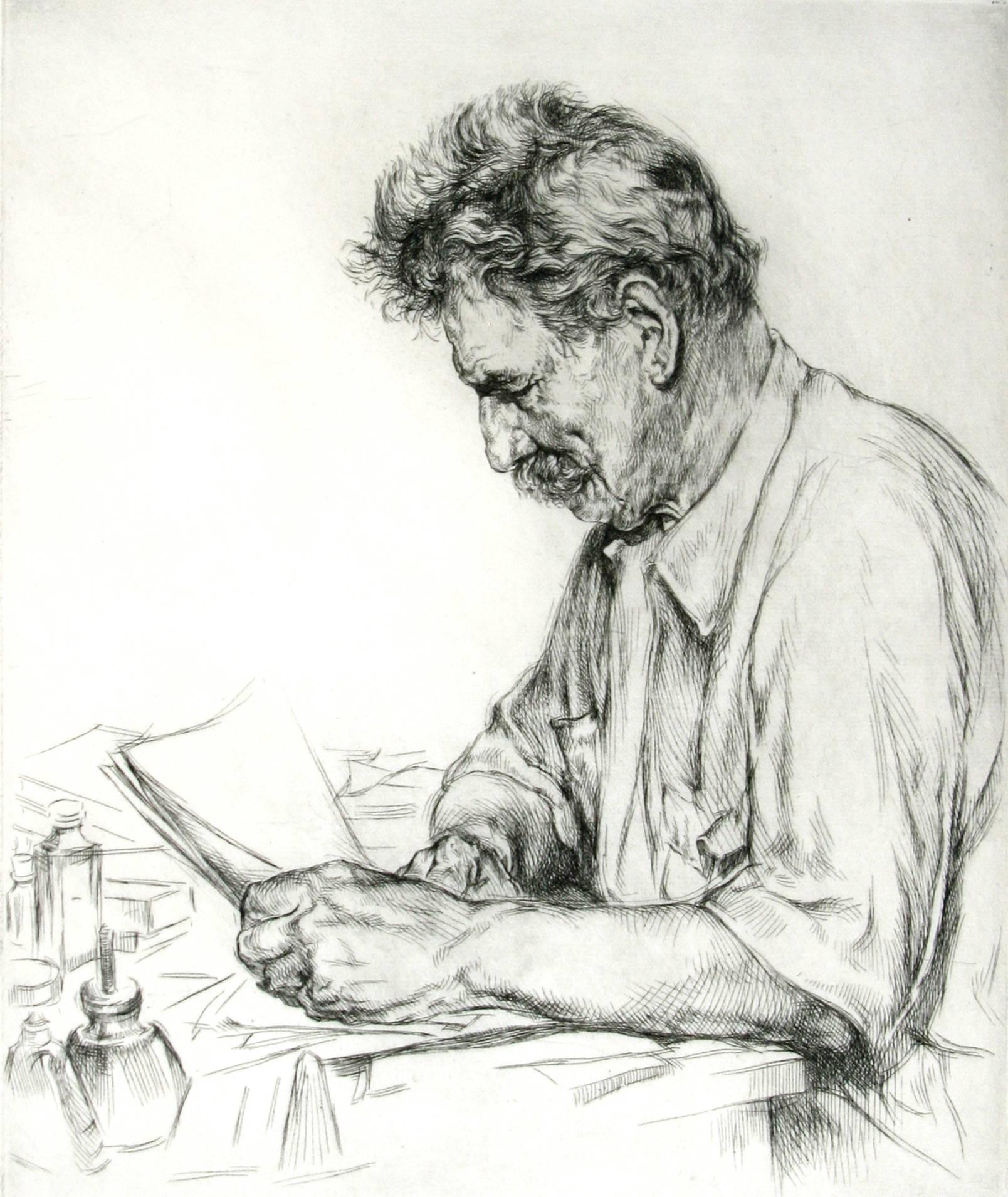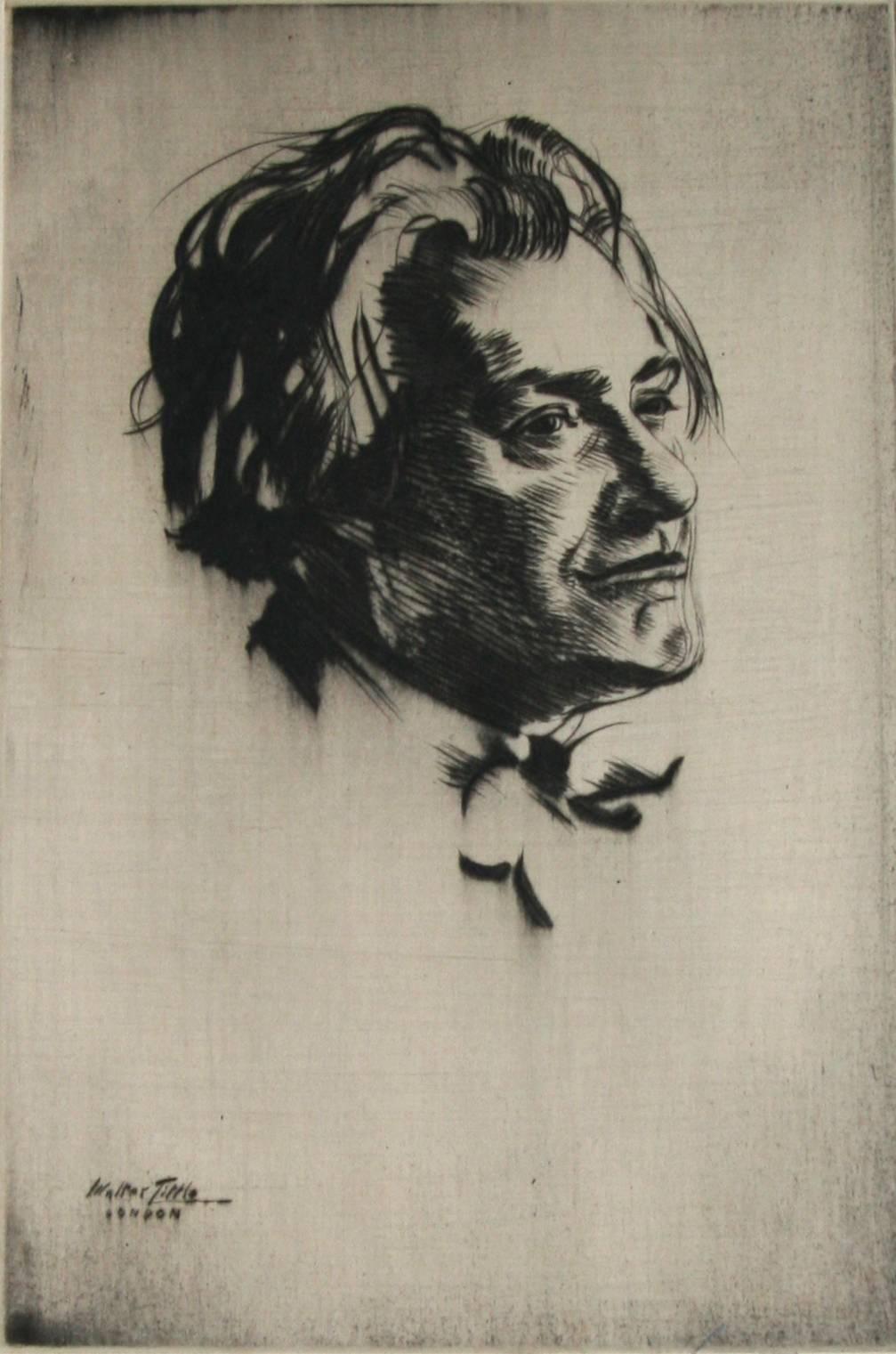Want more images or videos?
Request additional images or videos from the seller
1 of 6
Elie NadelmanWoman's Head1920
1920
About the Item
Edition of 50 printed by Charles White in 1951 for the estate
Bibliography:
Lincoln Kirstein, Elie Nademan (New York: The Eakins Press, 1973),, 20
Elie Nadelman
Born 1882, Warsaw, Poland
Died 1946, Bronx, New York
Born in occupied Poland, Elie Nadelman began his artistic training in Warsaw before leaving in 1902 to visit Munich, where he developed a passion for early Greek art. In 1905, soon after joining the Polish colony in Paris, he made his debut at the Salon d’Automne. When World War I broke out, Nadelman emigrated to New York with the help of his patron, Helena Rubinstein, and began to introduce genre subjects, such as popular dance, into his repertoire. He married Viola Spiess Flannery in 1919, and together they built the country’s largest collection of folk art, part of which was later documented by the Index of American Design. Consisting of more than 50,000 artifacts, the collection was unique in the US at the time for its inclusion of European objects. In 1926 their Museum of Folk and Peasant Arts opened in Riverdale in the Bronx. After the museum closed in 1937 due to lack of funds, Nadelman stopped exhibiting publicly, although he remained dedicated to his art. He committed suicide in 1946.
Despite his affinity for vernacular subjects, Nadelman was mainly celebrated for the stylized, streamlined grace of his Greek-inspired works. While his classical sculptures garnered an enthusiastic uptown collector base, the plaster genre figures he exhibited downtown beginning in 1917, followed soon by cherrywood and bronze versions, attracted only controversy. Nadelman’s disregard for the boundaries between high and low was also expressed in the organization of his folk art collection, which highlighted formal correspondences across time and space. His passion for folk art later inspired his largely unrealized ambition to produce works for a popular audience. To this end, in the late 1920s he replicated the look of bronze sculpture with more affordable galvano-plastique and made ceramic multiples with individualized touches and inventive patinas.
Dancer (1918) was the only one of Nadelman’s cherrywood vernacular figures to sell during his lifetime. Arranged in a pose reminiscent of Georges Seurat’s Le Chahut (1889–1890), its smooth and simplified wood surfaces are economically defined with a few touches of color. The fleshiness of Nadelman’s glazed ceramic and painted papier-mâché figures of the 1930s represents an increasing transgression of the values that defined his early classical sculptures, then taken further in the palm-sized plaster sculptures he produced beginning in 1938."
ourtesy National Gallery of Art, Washington
- Creator:Elie Nadelman (1885-1946, Polish)
- Creation Year:1920
- Dimensions:Height: 7.125 in (18.1 cm)Width: 5.375 in (13.66 cm)
- Medium:
- Movement & Style:
- Period:
- Condition:Relaxed vertical crease.
- Gallery Location:Fairlawn, OH
- Reference Number:
About the Seller
5.0
Recognized Seller
These prestigious sellers are industry leaders and represent the highest echelon for item quality and design.
Platinum Seller
These expertly vetted sellers are 1stDibs' most experienced sellers and are rated highest by our customers.
Established in 1978
1stDibs seller since 2013
713 sales on 1stDibs
Typical response time: 1 hour
Associations
International Fine Print Dealers Association
- ShippingRetrieving quote...Ships From: Fairlawn , OH
- Return PolicyA return for this item may be initiated within 10 days of delivery.
More From This SellerView All
- Woman's Head - Woman's Head in Profile (left) (Havard)By Elie NadelmanLocated in Fairlawn, OHWoman's Head - Woman's Head in Profile (left) (Havard) Drypoint, 1920 Unsigned (as issued) From: The Drypoints of Elie Nadelman, 21 unpublished prints by the sculptor, proof from th...Category
1920s American Modern Portrait Prints
MaterialsDrypoint
- Woman's Head in Profile - Woman's Head in Profile (left) (Havard)By Elie NadelmanLocated in Fairlawn, OHWoman's Head in Profile - Woman's Head in Profile (left) (Havard) Drypooint, 1920 Unsigned (as usual) From: The Drypoints of Elie Nadelman, 21 unpublished prints by the sculptor, pro...Category
1920s American Modern Portrait Prints
MaterialsDrypoint
- Self Portrait (With Model)By Raphael SoyerLocated in Fairlawn, OHSelf Portrait (With Model) Lithograph, 1959-1960 Signed and numbered in pencil (see photos) Edition: 50 (30/50) Commissioned by ACA Gallery, NYC Depicts the artist in his studio at S...Category
1950s American Modern Portrait Prints
MaterialsLithograph
- Miss TaylorBy Paul César HelleuLocated in Fairlawn, OHMiss Taylor Drypoint, c. 1900 Signed in pencil lower left (see photo) Small edition, about 10 Very rich impression, full of burr Condition: Excellent Image size: 21-1/4 x 13-1/4" Sheet size: 25 3/8 x 18 5/8" Reference: Montesquiou XII Paul César Helleu was born in Vannes, Brittany, France. His father, who was a customs inspector, died when Helleu was in his teens. Despite opposition from his mother, he then went to Paris and studied at Lycée Chaptal. In 1876, at age 16, he was admitted to the École des Beaux-Arts, beginning academic training in art with Jean-Léon Gérôme. Helleu attended the Second Impressionist Exhibition in the same year, and made his first acquaintances with John Singer Sargent, James McNeill Whistler, and Claude Monet. He was struck by their modern, bold alla prima technique and outdoor scenes, so far removed from the studio. Following graduation, Helleu took a job with the firm Théodore Deck Ceramique Française hand-painting fine decorative plates. At this same time, he met Giovanni Boldini, a portrait painter with a facile, bravura style, who became a mentor and comrade, and strongly influenced his future artistic style. When he was 18 years old, Helleu established a close friendship with John Singer Sargent, four years his senior, that was to last his lifetime. Already becoming established, Sargent was receiving commissions for his work. Helleu had not sold anything, and was deeply discouraged almost to the point of abandoning his studies. When Sargent heard this, he went to Helleu and picked one of his paintings, praising his technique. Flattered that Sargent would praise his work, he offered to give it to him. Sargent replied, "I shall gladly accept this, Helleu, but not as a gift. I sell my own pictures, and I know what they cost me by the time they are out of my hand. I should never enjoy this pastel if I hadn't paid you a fair and honest price for it." With this he paid him a thousand-franc note. Helleu was commissioned in 1884 to paint a portrait of a young woman named Alice Guérin (1870–1933). They fell in love, and married on 28 July 1886. Throughout their lives together, she was his favourite model. Charming, refined and graceful, she helped introduce them to the aristocratic circles of Paris, where they became popular fixtures. On a trip to London with Jacques-Émile Blanche in 1885, Helleu met Whistler again and visited other prominent artists. His introduction to James Jacques Tissot, an accomplished society painter from France who made his career in England, proved a revelation. In Tissot, Helleu saw, for the first time, the possibilities of drypoint etching with a diamond point stylus directly on a copper plate. Helleu quickly became a virtuoso of the technique, drawing with the same dynamic and sophisticated freedom with his stylus as with his pastels. His prints were very well received, and they had the added advantage that a sitter could have several proofs printed to give to relations or friends. Over the course of his career, Helleu produced more than 2,000 drypoint prints. Soon, Helleu was displaying works to much acclaim at several galleries. Degas encouraged him to submit paintings to the Eighth Impressionist Exhibition in May and June 1886. The show was installed in a Paris apartment at 1 rue Laffitte, which ran concurrently with the official Salon that year to make a statement. Although 17 artists joined the famous exhibit that included the first Neo-Impressionistic works, Helleu, like Monet, refused to participate. Paul Helleu Sketching with His Wife (1889), by John Singer Sargent, The Brooklyn Museum, New York In 1886, Helleu befriended Robert de Montesquiou, the poet and aesthete, who bought six of his drypoints to add to his large print collection. Montesquiou later wrote a book about Helleu that was published in 1913 with reproductions of 100 of his prints and drawings. This volume remains the definitive biography of Helleu. Montesquiou introduced Helleu to Parisian literary salons, where he met Marcel Proust, who also became a friend. Proust created a literary picture of Helleu in his novel Remembrance of Things Past as the painter Elstir. (Later, Helleu engraved a well-known portrait of Proust on his deathbed.) Montesquiou's cousin, the Countess Greffulhe, enabled Helleu to expand his career as a portrait artist to elegant women in the highest ranks of Paris society, portraits that provide the basis for his modern reputation. His subjects included the Duchess of Marlborough, the Marchesa Casati...Category
Early 1900s Art Nouveau Portrait Prints
MaterialsDrypoint
- Untitled (Portrait)By William H. BaileyLocated in Fairlawn, OHUntitled (Portrait) Drypoint printed in blue-black graphite mixed with silver, 1974 Signed and dated lower ight (see photo) From: Series entitled Six Drypoints Edition: 23 (4/23) Numbered lower left (see photo) Print Shop: Crown Point Press Printer: Jeannie Fine Publisher: Parasol Press, New York Note: A portfolio is in the collection of the National Gallery, Australia, Fine Arts Museums of San Francisco- de Young/Legion of Honor, Davis Museum at Wellesley College and the Yale University Art Gallery. Condition: Excellent Image/Plate size: 6 3/8 x 5 3/8 inches Sheet size: 24 x 20 inches From a portfolio of six drypoints, printed with unqiue combination of blue-black graphite shavings combined with silver to create the appearence of an original drawing. I know of no other artist to use a similar printing technique. William Bailey studied art at the University of Kansas, Yale University and Yale School of Art where he studied with Josef Albers receiving his MFA in 1957. Mr. Bailey’s first exhibition in New York was at Robert Schoelkopf Gallery in 1968, where he showed regularly until its closing in 1990. During the 90’s he exhibited at the Andre Emmerich Gallery and on its closing, exhibited at the Robert Miller Gallery. In 2004 Bailey moved to the Betty Cuningham Gallery where his most recent exhibition was held from April 30 - June 11, 2016. Mr. Bailey’s work has been exhibited extensively in both America and Europe. He is represented in the collections of The Whitney Museum of American Art, The Museum of Modern Art, the Pennsylvania Academy of Fine Arts, and the Hirschhorn Museum and Sculpture Garden, among others. He was awarded a Guggenheim Fellowship in painting in 1965. Mr. Bailey was elected to The National Academy of Design in 1983 and to The American Academy of Arts and Letters in 1986. Mr. Bailey taught at The Yale School of Art from 1958 to 1962 and from 1969 to 1995. He has also taught at The Cooper Union, University of Pennsylvania and Indiana University. He maintains studios in New Haven and in Umbertide, Italy. Courtesy Betty Cunningham Gallery Tribute to William Bailey THE NEW YORK TIMES William Bailey, whose pristine, idealized still lifes and female nudes made him one of the leading figures in the return of figurative art in the 1980s, died on April 13 at his home in Branford, Conn. He was 89. His death was confirmed by his daughter, Alix Bailey. Beyond his painting, Mr. Bailey influenced generations of students in his many years as a teacher at the Yale School of Art. In some of his best-known work, Mr. Bailey arranged simple objects — the eggs, bowls, bottles and vases that he once called “my repertory company” — along a severe horizontal shelf, or on a plain table, swathing them in a breathless, deceptively serene atmosphere heavy with mystery. William Bailey, Modernist Figurative Painter, Dies at 89 He swathed his nudes and still lifes of eggs, vases, bottles and bowls in a breathless, deceptively serene atmosphere heavy with mystery. The painter William Bailey in 2009. He was never given a career survey in a major museum, but his influence, particulary on students at Yale, was deep. Ford Bailey By William Grimes for the New York Times April 18, 2020 William Bailey, whose pristine, idealized still lifes and female nudes made him one of the leading figures in the return of figurative art in the 1980s, died on April 13 at his home in Branford, Conn. He was 89. His death was confirmed by his daughter, Alix Bailey. Beyond his painting, Mr. Bailey influenced generations of students in his many years as a teacher at the Yale School of Art. In some of his best-known work, Mr. Bailey arranged simple objects — the eggs, bowls, bottles and vases that he once called “my repertory company” — along a severe horizontal shelf, or on a plain table, swathing them in a breathless, deceptively serene atmosphere heavy with mystery. His muted ochres, grays and powdery blues conjured up a still, timeless world inhabited by Platonic forms, recognizable but uncanny, in part because he painted from imagination rather than life. “They are at once vividly real and objects in dream, and it is the poetry of this double life that elevates all this humble crockery to the realm of pictorial romance,” Hilton Kramer wrote in The New York Times in 1979. Mr. Bailey’s female figures, some clothed in a simple shift or robe and others partly or entirely nude, are disconcertingly impassive, implacable and unreadable, fleshly presences breathing an otherworldly air. The critic Mark Stevens, writing in Newsweek in 1982, credited Mr. Bailey with helping to “restore representational art to a position of consequence in modern painting.” But his version of representation was entirely idiosyncratic, seemingly traditional but in fact “a modernism so contrarian,” the artist Alexi Worth wrote in a catalog essay for the William Harrison Bailey was born on Nov. 17, 1930, in Council Bluffs, Iowa. His father, Willard, worked in radio advertising and moved the family from city to city in the Midwest. Bill was in his early teens when his father died. His mother, Marjorie (Cheyney) Bailey, was a homemaker who later worked as an accountant for her second husband, Fred...Category
1970s Realist Portrait Prints
MaterialsDrypoint
- Chinois inventa, dit-on, la poudre a canon, nous en fit donBy Georges RouaultLocated in Fairlawn, OHChinois inventa, dit-on, la poudre a canon, nous en fit don (The Chinese invented gunpowder, they say, and made is a gift of it) Aquatint, roulette, drypoint, acid bite, and scorper, 1926 From: Miserere, Plate 38 Initially started by Ambrose Vollard, this portfolio was published in 1948 by Editions de l'Etoile Filante, Paris This image is the cover illustration for the 1938 MOMA catalog...Category
1920s French School Portrait Prints
MaterialsDrypoint, Aquatint
You May Also Like
- Man By a Radiator.By Clifford Isaac AddamsLocated in Storrs, CTMan By a Radiator. 1912. Etching. Hausberg catalog 247 state iii/iv. Only 2 impressions in this state. 16 x 8 7/8 (sheet 8 x 10 3/8). Vertical printing fold. Printed by the artist on...Category
Early 20th Century American Modern Portrait Prints
MaterialsDrypoint, Etching
- JanineBy Arthur William HeintzelmanLocated in Storrs, CT9 5/16 x 8 1/4 (sheet 15 1/4 x 12 3/4). Toning in the image; otherwise good condition. A rich impression with plate tone printed on cream wove paper. Signed in pencil. Housed in a 20...Category
Mid-20th Century American Modern Portrait Prints
MaterialsDrypoint, Etching
- The Box at 'Faustus'By Diana ThorneLocated in Storrs, CTThe Box at 'Faustus'. 1929. Drypoint. 11 x 8 7/8. Edition 100, #39. Signed, titled, and numbered in pencil. A rich impression printed on the full sheet of pale blue/green-toned wove paper. Signed in pencil. A tongue-in-cheek image of the devil in the opera box...Category
1920s American Modern Portrait Prints
MaterialsEtching, Drypoint
- Portrait of Albert Schweitzer.By Arthur William HeintzelmanLocated in Storrs, CTPortrait of Albert Schweitzer. Etching. 11 3/4 x 9 3/4 (sheet 16 1/4 x 14). Illustrated: Beall, American Prints in the Library of Congress, page 205....Category
1950s American Modern Interior Prints
MaterialsEtching, Drypoint
- Portrait of James McBey.By Walter TittleLocated in Storrs, CTJames McBey. 1931. Drypoint. 8 7/8 x 5 7/8 (sheet 11 1/2 x 9 ). An extremely rich impression with drypoint burr, printed by the artist on cream wove paper. Signed in the plate lower ...Category
1930s American Modern Portrait Prints
MaterialsDrypoint, Etching
- Bibi ValentinBy James Abbott McNeill WhistlerLocated in Storrs, CTBibi Valentin. 1859. Etching and drypoint. Kennedy catalog 50 state ii; Glasgow catalog 34 state ii. 6 x 8 7/8 (sheet 8 11/16 x 10 11/16). Glasgow records 44 known impressions. A rich impression with burr, printed on watermarked laid paper with full margins. Signed and dated in the plate. Housed in a 20 x 16-inch archival mat A young girl, sits facing the viewer, leaning on her left elbow, legs extended to left. She wears a high-necked smock and buttoned boots...Category
19th Century American Modern Portrait Prints
MaterialsEtching, Drypoint
